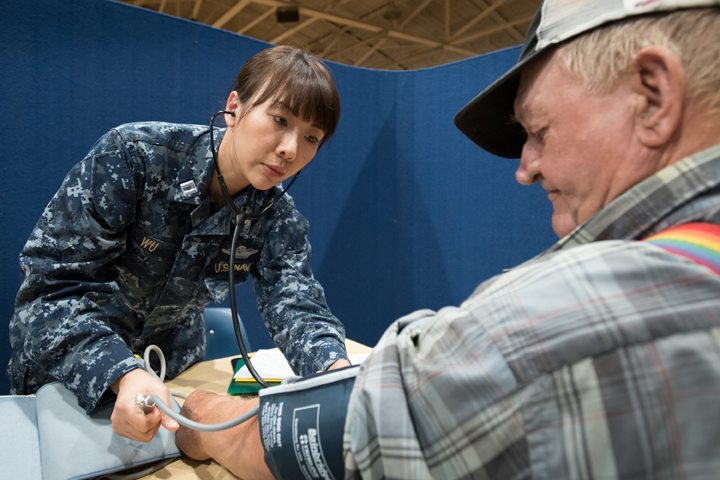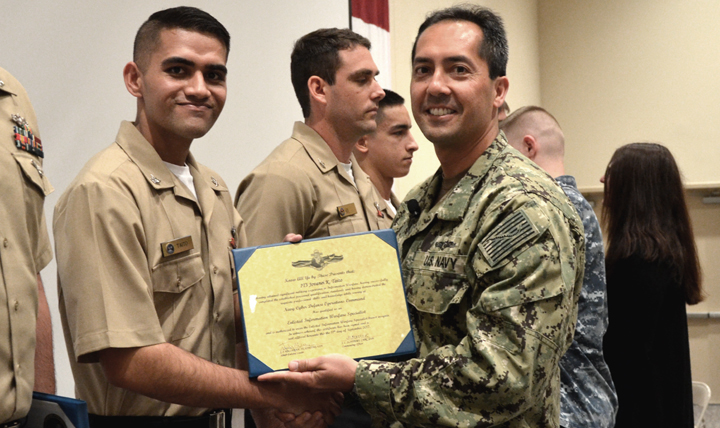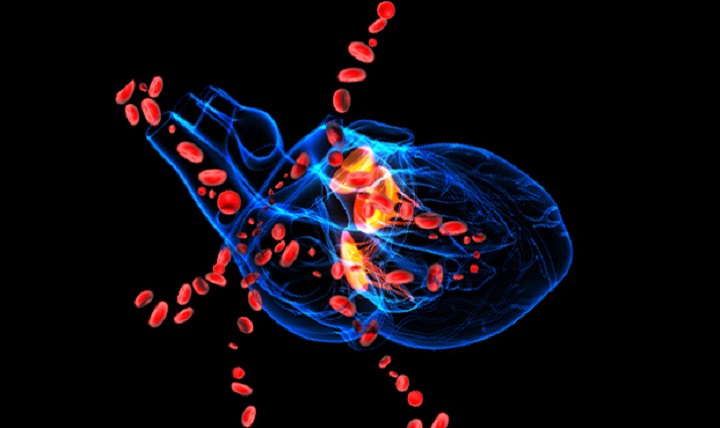
Too much pressure: Hypertension a leading cause of heart disease

Navy Lt. Xin Wu, a nurse from Expeditionary Medical Facility Bethesda in Maryland, checks a patient's blood pressure at a health care clinic set up by the Air Guard and Navy Reserve at a high school in Beattyville, Kentucky. The clinic was part of a mission to train military medical personnel while offering free health care to Eastern Kentucky residents. (U.S. Air Force photo by Lt. Col. Dale Greer)
Air Force Lt. Col. Bryan White says he's passionate about educating people on hypertension, the clinical term for high blood pressure.
"Forty percent of all heart disease can be attributed to hypertension," said White, a cardiologist at Nellis Air Force Base in Nevada, citing statistics from the American Heart Association, or AHA. "And lifestyle choices people make when they're younger may play a huge role in the development of high blood pressure later in life."
To understand the role hypertension plays in poor heart health, it’s helpful to understand some basic human anatomy and physiology. The heart pumps blood to cells and tissues, carrying oxygen and nutrients and removing waste materials. Arteries are the vessels that carry that oxygenated blood from the heart to the rest of the body. The artery walls expand when the heart beats; they contract between beats, when the heart is at rest.
As blood flows through the arteries, it exerts pressure against the artery walls. When the arteries sense too much pressure, the walls respond by pushing back. Over time, this action thickens the arteries, causing them to narrow. Arteries become less flexible which limits blood flow. Meanwhile, blood pressure builds, causing damage to the arteries.
Because this process is gradual, people may be unaware until a heart attack or other medical crisis occurs. Heart disease is a leading cause of death in the United States, according to the Centers for Disease Control and Prevention, or CDC.
Blood pressure is expressed as two numbers referring to millimeters of mercury, or mmHg. The first number, or systolic, is the measure of the pressure of the blood against artery walls when the heart is beating. The second, or diastolic, indicates the pressure against artery walls between beats, when the heart is at rest.
Blood pressure measurements are two numbers. The first number measures the pressure in your blood vessels when your heart beats; the second number measures the pressure in your vessels when your heart rests. According to the CDC, a blood pressure reading is considered normal when the first number is less than 120 and the second number is less than 80 mmHg. People are considered at risk for hypertension when their blood pressure falls in the range of 120-139/80-89 mmHg. High blood pressure is 140 or higher/90 or higher mmHg.
Hypertension may be hereditary, White said. According to the AHA, more than 40 percent of African-Americans in the United States have hypertension, which may develop earlier in life and become more severe.
Health care experts say high blood pressure can also is caused by unhealthy lifestyle habits, including smoking, lack of exercise, and a diet heavy in saturated fats and salt. About 25 percent of Americans ages 25 to 45 have hypertension, according to the AHA. The prevalence increases to 45 percent of people 45 to 65 years old, and 80 percent of Americans older than 65.
"It's primarily an age-related disorder," White said.
However, a study of approximately 3,800 young U.S. service members wounded in the Iraq and Afghanistan wars found that severe injuries and chronic post-traumatic stress disorder were risk factors for hypertension.
Air Force Lt. Col. Ian Stewart, a physician at Travis Air Force Base in California, was senior author of the study, which was published in the AHA journal Hypertension in March 2018. The average age of the service members when they were wounded was 26, Stewart said.
"We've done previous work demonstrating that the severity of combat injury is associated with hypertension," Stewart said. "But we found that both injury severity and PTSD increased the risk of hypertension independently from one another," he said. "These findings suggest that caring for veterans requires a holistic approach that encompasses physical as well as mental health."
TRICARE covers blood pressure screenings for adults to check for cardiovascular disease at least every two years. Also, getting blood pressure checked is a routine part of every visit to a medical clinic. However, there's often not enough time to follow suggested protocol for the most accurate reading, White said. That includes the patient sitting calmly for five minutes before a blood pressure check, and checking the blood pressure three times. The recorded blood pressure should be an average of the three readings, White said. Further, a diagnosis of hypertension shouldn't be made until at least two office visits where high blood pressure is recorded using this method.
Medications to control hypertension have risks for kidney and liver damage and may affect deployability, White said. So for patients 45 or younger, he first prescribes six months of lifestyle changes including increasing exercise, eliminating smoking, and eating a heart-healthy diet.
"A lot of hypertension is linked to people simply not taking care of themselves," White said. "There's so much people can do to prevent its development."
Sudden cardiac death in young athletes
Article
3/7/2019

Sudden cardiac events can occur in seemingly healthy young people in their teens or twenties, including young servicemembers
Focus on heart-healthy diet is perfect fit for February
Article
2/22/2019

With the typical American diet and lifestyle, many people put themselves at risk for developing various heart diseases
Taking care of your heart with TRICARE benefits
Article
2/19/2019

Getting preventive screenings now could save your life tomorrow
Deep vein thrombosis: What you need to know
Article
4/9/2018

Everyone’s potentially at risk, vascular surgeon says
Small changes, big results: Healthy lifestyle choices can make a difference for heart health
Article
4/6/2018

Risk for heart disease, the number one killer of Americans every year, can be decreased through healthy lifestyle and nutrition choices
Parents and doctors watch over a tiny heart
Article
3/19/2018

A military family’s rocky medical road with congenital heart disease
Focus on prevention … not the cure for heart disease
Article
2/21/2018

Many heart health problems can be avoided
Lose to win: Some service members struggle with weight
Article
2/7/2018

With numbers rising, programs help keep you shipshape
Heart Health Month: Stopping the number-one killer
Article
2/1/2018

Learn about the small changes that can make a big difference in your overall health
Men's Health: Heart disease
Article
6/27/2017

According to the Centers for Disease Control and Prevention, 321,000 men died from heart disease in 2013, or one in every four male deaths
Absolute and Relative Morbidity Burdens Attributable to Various Illnesses and Injuries, Active Component, U.S. Armed Forces, 2016
Infographic
6/19/2017

This infographic documents healthcare burdens attributable to cardiovascular diseases among active component, U.S. Armed Forces in 2016.
To salt or not to salt?
Article
4/20/2017

It’s important to watch your sodium intake because it can increase your risk of high blood pressure, heart disease, stroke and some cancers
Healthy hearts, healthy lives: recognizing heart disease in women
Article
3/9/2017

Heart disease in women can be harder to detect when the symptoms aren’t always the same, or as prominent, as they are in men
Heart Disease and Its Effects on Service Members
Infographic
6/8/2016

Cardiovascular disease comprises disorders of the heart and circulatory system including coronary heart disease and cerebrovascular disease. This infographic provides data on the risk factors for cardiovascular disease among military members base on diagnostic codes in the electronic health records of service members during a 10-year surveillance period.
The ABC's of Heart Health
Infographic
2/22/2016

Bring awareness to the risks of heart disease and ways to stay heart healthy.






















.png)











No hay comentarios:
Publicar un comentario